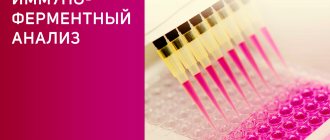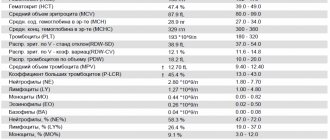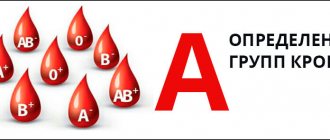Alloimmune antibodies are one of the most important erythrocyte antigens that are synthesized by the body during sensitization to Rh factor proteins and some other protein compounds contained on the membrane of erythrocytes.
For the appearance of these antibodies, specific conditions are required:
- Blood transfusion to an incompatible recipient.
- The period of pregnancy when an Rh-negative woman carries a fetus with a positive Rh status.
The Rh system consists of 5 main antigens and many additional ones; antigen D is considered the most active. There are other antierythrocyte antigens that are not part of the Rh factor, but are of clinical importance. They can cause dangerous complications during pregnancy and blood transfusions.
Study Information
The Rh factor and other immunogenic proteins of the erythrocyte membrane are inherited. The majority of the population (about 85%) belongs to the group of Rh-positive, that is, these specific proteins are present in the membrane of their blood cells. In a certain number of people they are not synthesized; they are classified as Rh-negative.
The absence or presence of the Rh factor does not in any way affect the general condition of a person. But situations may arise when an Rh-negative woman becomes pregnant with an Rh-positive child. In this case, there is a risk that the mother’s body will begin to produce antibodies against the baby’s blood. The result can be hemolytic disease of the newborn, miscarriage, and a number of other complications of pregnancy.
During the first pregnancy, the risks for the child are small, but the antibodies persist for a long time. The risk of Rh conflict increases rapidly with each subsequent pregnancy. Antibodies circulate in the blood for a long time and freely penetrate the placental barrier. Determination of antibodies to Rh antigens of erythrocytes is a reliable, reliable method for detecting the likelihood of Rh conflict in the early stages of pregnancy.
The presence of high antibody titers may be the cause of hemolytic disease. In this disease, antibodies from the mother's blood penetrate into the fetus and destroy red blood cells in the child's blood. As a result, hemolytic jaundice develops, affecting the kidneys, liver, and other organs of the newborn.
The analysis allows you to determine the presence of antibodies in the early stages of pregnancy, monitor the dynamics of the development of the process, and promptly prescribe appropriate treatment.
This test is also used before blood transfusion to determine the potential incompatibility of the donor’s blood with the recipient’s Rh system. Especially if the patient has previously received a blood transfusion.
The analysis is carried out using the method of agglutination, that is, gluing. It implies that the presence of specific antibodies in the blood will manifest itself when it is mixed with the corresponding antigens. Red blood cells will stick together and precipitate. If agglutination occurs, the analysis is considered positive; if not, it is considered negative.
Toxoplasmosis
Toxoplasmosis is a widespread disease caused by the intracellular protozoan parasite Toxoplasma gondii. The primary host of Toxoplasma, in whose body this parasite multiplies, is the domestic cat, which most often becomes the source of human infection. In addition, human infection can also occur through food contaminated or contaminated with parasite oocysts. The disease can be transmitted transplacentally to the fetus from an infected mother. Cases of infection transmission through blood transfusion and organ transplantation have been described.
Toxoplasmosis affects almost 30% of people in the world. In adults, toxoplasmosis is often asymptomatic; sometimes there may be headache, sore throat, asthenia, and in rare cases lymphadenitis. In exceptional cases, toxoplasma can cause myocarditis, hepatitis, pneumonia, meningoencephalitis, and eye damage. After the illness, stable immunity to toxoplasma is developed.
Toxoplasmosis is a serious danger when a woman is initially infected during pregnancy. If a woman suffered from the disease before pregnancy (at least six months), toxoplasmosis does not threaten her unborn child, but if a woman is infected during pregnancy, then much depends on at what stage of pregnancy toxoplasma entered the pregnant woman’s body. The most dangerous infection is considered to be toxoplasmosis in the first trimester. In these cases, congenital toxoplasmosis often leads to the death of the fetus or the development of severe damage to the eyes, liver, spleen, and nervous system of the child.
The frequency of fetal infections varies depending on at what stage of pregnancy the mother was infected:
- less than 5% when the mother is infected in the first trimester;
- more than 60% when the mother is infected in the third trimester.
If the mother becomes infected later in pregnancy, the risk of transmission of the infection to the fetus is very high, but the risk of severe damage to the fetus is reduced. If a woman has not had toxoplasmosis, then infection during pregnancy can be prevented by observing basic hygiene rules:
- During pregnancy, there should be no contact with cats, especially young ones, because cats infected with toxoplasmosis also develop immunity to it as they age.
- Avoid working with soil in the garden; if you cannot avoid it completely, then you should only work with gloves.
- All vegetables, fruits, and herbs must be thoroughly washed before use.
- Avoid contact with raw meat; all meat dishes must be thoroughly boiled or fried.
The diagnosis of toxoplasmosis is made on the basis of clinical data and laboratory examination data (determination of antibodies to Toxoplasma gondii in the blood).
IgM antibodies to Toxoplasma gondii appear in the blood 2-4 weeks after infection and disappear after 3-9 months. Next, antibodies of the IgG class appear, and their titer gradually increases, and 2-5 months after infection reaches a peak.
Do you need preparation for the study?
To conduct the study, blood is taken from a vein from the patient and given in the morning, on an empty stomach. Before the analysis, you are allowed to drink water, even coffee or tea should be excluded.
The day before the test, you need to avoid physical activity and not drink alcohol or fatty foods in large quantities. The time period between the last meal and blood donation is at least 8 hours. Before the test, you should not smoke, at least 30 minutes before the analysis.
Failure to follow the rules for preparing for analysis will greatly reduce the reliability of test results and increase the likelihood of false-positive reactions.
Herpes
Herpes is a group of viral infectious diseases that are caused by the herpes simplex virus (HSV). HSV is a DNA virus that is morphologically similar to other viruses of the Herpetoviridae family. There are two types of HSV, with different biological and epidemiological features. Type I affects the mucous membranes of the eyes, mouth, and nose and is one of the causes of severe sporadic encephalitis in adults. Type II in most cases affects the genitals (so-called urogenital herpes). HSV is transmitted by airborne droplets and sexually, as well as transplacentally from the pregnant mother to the fetus. In the case of an advanced chronic course of the disease, herpes of both types can manifest itself as lesions not only of the skin and mucous membranes, but also of the central nervous system, eyes, and internal organs. As with all TORCH infections, when infected with herpes, a person produces antibodies that significantly reduce further progression of the disease, and herpes most often appears only when immunity is reduced (such as type I herpes during a cold).
With primary infection with herpes during pregnancy, especially at its initial stage, when all the organs and systems of the unborn child are formed, the herpes infection can be fatal to the fetus. In this case, the risk of undeveloped pregnancy and miscarriages triples, and the development of deformities in the fetus is possible. If herpes infection occurs in the second half of pregnancy, then the likelihood of congenital fetal anomalies, such as microcephaly, retinal pathology, heart defects, and congenital viral pneumonia, increases. Premature birth may occur. A child can become infected with herpes not only in utero, but also during childbirth, passing through the birth canal of an infected mother. This happens if during pregnancy a woman’s genital herpes worsens, and the rashes are localized on the cervix or in the genital tract.
Primary infection occurs in seronegative patients who have never been infected. Secondary infection is the activation of latent infection or reinfection in seropositive patients.
Most people infected with HSV are asymptomatic, so serological diagnosis is necessary.
IgM antibodies to herpes simplex virus are detected one week after infection, usually indicative of recent or current infection.
IgG antibodies appear 2-3 weeks after infection, and their titer decreases after several months. In patients with relapse of the disease, the IgG antibody titer often does not increase.
What do the study results mean?
If the test result is negative, the likelihood of Rh conflict is low, no additional action is required. Repeated tests may be performed to exclude rare cases of false negative reactions.
Positive test results indicate the presence of specific antibodies in the blood. This indicates a high probability of Rh conflict. In this case, it may be necessary to prescribe measures to prevent hemolytic disease of the newborn and carefully select compatible donor blood.
The immune response of a woman’s body to blood cell antigens inherited by the fetus can lead to the development of hemolytic disease of the newborn (HDN), neonatal immune thrombocytopenia and leukopenia, and cause premature termination of pregnancy and infertility [1, 3, 9]. Adequate prevention and treatment of these pathological conditions is impossible without timely diagnosis of immunoconflict between mother and fetus, establishing the specificity and titer of alloantibodies [4, 5, 8, 10]. In addition, every pregnant woman should be considered as a potential recipient of hemocomponent therapy and, in the presence of allosensitization, needs an individual selection of immunologically compatible blood components [2, 7, 11].
The purpose of the study was to determine the clinical significance of immunohematological monitoring in women of reproductive age.
The objectives of the study were to study the prevalence of immune antibodies to erythrocyte and leukocyte antigens (HLA), to establish the role of identified antibodies in the development of hemolytic disease of the newborn and premature spontaneous termination of pregnancy.
Material and methods
An immunohematological examination was carried out on 1850 married couples planning to have a child. Detection of immune (IgG) antibodies to antigens of the AB0 system was carried out using a 5% solution of unithiol (Na 2,3-dimercaptopropanesulfonate) in an agglutination reaction in accordance with Methodological Letter of the Ministry of Health of the Slovak Republic of the Russian Federation No. 15-4/3118-09 [6]. The study of antierythrocyte alloantibodies to Rhesus, Kell, MNSs, etc. antigens was carried out in an indirect antiglobulin test in a gel with a panel of 3 test erythrocyte samples. If antibodies were present in the blood serum, their specificity was determined using 11 samples of test red blood cells. The antibody titer was taken to be the value of the highest serum dilution in which agglutination was clearly visible. Anti-lymphocyte antibodies (anti-HLA) were determined in a standard complement-dependent microlymphocytotoxicity test.
Results and discussion
The study of immune antibodies to antigens of the AB0 system was carried out in the presence of a theoretical possibility of AB0 incompatibility in a particular married couple. IgG antibodies were detected in 350 (41.1%) of 851 women examined. At the same time, anti-A antibodies were detected significantly more often (47.3%) than anti-B (34.1%) ( p
<0,05).
The dependence of the occurrence of tension-type headache on the titer of immune antibodies anti-A, anti-B was studied based on the analysis of data from laboratory and clinical examinations of 283 married couples with children. Symptoms of TTH at birth were diagnosed in 57 (20.1%) children (Table 1)
.
At the same time, antibodies of a specificity other than AB0 were not detected in the blood serum of these women. The incidence of TTH development directly correlated with the antibody titer ( p
<0.01). With an antibody titer of 1:4, clinical manifestations of HDN were observed in 25% of children. The presence of immune antibodies in women at a titer of 1:8 or higher led to the development of tension-type headache in more than 70% of cases.
Screening of anti-erythrocyte alloantibodies in the indirect antiglobulin test was carried out in blood samples of 1850 women. Allosensitization was detected in 7 (0.86%) of 811 examined women with Rh-positive blood and in 53 (5.1%) of 1039 women with Rh-negative blood. The results of antibody identification are presented in table. 2
.
When analyzing the dependence of the development of Rh(D) sensitization on the number of pregnancies in women's history, it was found that the first pregnancy leads to the initiation of an immune response to the D antigen in 0.91% of women, and each subsequent pregnancy increases the likelihood of antibody formation. In women with a history of 5 or more pregnancies, Rh sensitization is 17.11%. Significant differences were found in the frequency of detection of antibodies in women who had one pregnancy, who had 2-4 and 5 pregnancies or more ( p
<0,01)
(Table 3)
.
The titer of antierythrocyte alloantibodies varied from 1:2 to 1:32,000 and did not depend on the number of pregnancies. An increase in antibody titer during pregnancy was observed in 21.4% of those examined, titer fluctuations (including after sessions of therapeutic plasmapheresis) - in 35.8%, a decrease without plasmapheresis - in 7.1%, titer without changes - in 35.7 % of sensitized women.
The dependence of the formation of anti-D antibodies on the ABO affiliation of the spouses was studied (Table 4)
.
Antibodies were detected in 26 (4.63%) of 562 women whose husbands were of the same group or compatible with them according to the AB0 system. In case of antigen A incompatibility, for example, the wife’s blood group is 0(I), the husband’s is A(II), D-immunization was established in 8 (3.32%) of the 241 women examined. When spouses differed in antigen B, Rh sensitization was detected in 12 (5.53%) of 217 cases. Statistical differences between groups were not significant ( p
>0.05). Thus, our results are not consistent with the hypothesis that the risk of developing allosensitization decreases when spouses are incompatible with AB0 antigens.
Of the 60 alloimmunized women, 18 (30%) had a history of giving birth to children with HDN, 14 (23.3%) had spontaneous abortion, and 3 (5%) were diagnosed with II infertility. The reason for the development of HDN was the presence of a titer of anti-D, -DC, -c, -E, -K antibodies (Table 5)
.
Anti-HLA antibodies were detected in 13 (0.7%) of 1850 women examined. The number of pregnancies in women's history was decisive in the development of HLA sensitization. During the first pregnancy, anti-HLA antibodies arose in 0.3% of women, in the 2nd-4th pregnancy - in 1.5%, with a history of 5 pregnancies or more - in 6.58% ( p
<0.05).
In women who were not pregnant, anti-HLA antibodies were not detected. The effect of anti-HLA antibodies on the course and outcome of pregnancy has not been established. In the group of HLA-sensitized women, premature spontaneous termination of pregnancy was recorded in 25% of cases, in the group of non-sensitized women - in 20% ( p
>0.05).
Thus, an immunohematological examination of married couples planning the birth of a child should include mandatory determination of the AB0 blood group and Rhesus status of both spouses, the study of immune antibodies to erythrocyte antigens of the ABO, Rhesus, Kell systems, etc. When identifying antibodies, it is necessary to determine their belonging to the class immunoglobulins, titer and specificity. The data obtained will make it possible to predict the risk of developing HDN and, if necessary, select compatible blood components for transfusion to both the newborn and the mother. The absence of anti-Rhesus antibodies in Rh-negative women is an indication for the prevention of sensitization by administering anti-Rhesus immunoglobulin after childbirth or premature termination of pregnancy.
conclusions
1. Immune antibodies (IgG) of the AB0 system are detected in 41.1% of women with AB0 incompatibility with their spouse.
2. The risk of developing hemolytic disease of newborns is associated with the titer of anti-A and anti-B antibodies, while a titer of 1:4 or higher can be considered diagnostic, at which HDN is observed in more than 25% of cases.
3. Alloantibodies to erythrocyte antigens of the Rh, Kell and other systems are found in 5.1% of Rh-negative and 0.86% of Rh-positive women of reproductive age.
4. The risk of Rh sensitization is directly dependent on the number of pregnancies in women’s history and does not depend on the ABO status of the spouses.
5. Anti-HLA antibodies were detected in 0.7% of women, but the effect of HLA sensitization on the course and outcome of pregnancy has not been established.
How to test for Rh conflict during pregnancy
If the Rh factor is negative, the expectant mother is registered and must undergo regular monitoring for Rh sensitivity until delivery. If signs of sensitization are detected - immunoglobulins of the IgM or IgG class appear in the mother's blood, an analysis should be done:
- up to 20 weeks – 1 time per month;
- from 20 to 30 weeks – once every 4 weeks;
- from 30 to 36 weeks – once every 2 weeks;
- last month – 1 time per week.
The most significant in the diagnosis of immunological incompatibility are the indicators of IgG antibodies. They are usually denoted by the ratio of numbers, which are called titers.
With values:
- 1:16 amniotic fluid is punctured to collect amniotic fluid. Based on the level of immunoglobulins in the water, the doctor determines the condition of the fetus: if the antibody level is above 0.16, the development of HDN is diagnosed; above 0.7, possible fetal death. The procedure is called amniocentesis and is prescribed no earlier than 33 weeks of pregnancy.
- 1:32 shows the cordocentesis procedure. Using the method of puncture of the umbilical cord vessels, fetal blood is collected and sent for analysis.
Where can I donate blood for testing?
To take a blood test for anti-Rhesus antibodies, contact the medical office, located in the Moscow JSC and offering the services of its own modern clinical laboratory. In our clinic, consultations are conducted by highly qualified, experienced doctors who practice an individual, very attentive approach to patients and adhere to modern diagnostic and treatment methods. Our specialists have European-class equipment at their disposal, which gives the most accurate results in the shortest possible time.
You can find out the price of testing for antibody titers during pregnancy either on the clinic’s website or by calling. The administrator will sign you up for a convenient date and time and will answer all questions that arise during the registration process.







